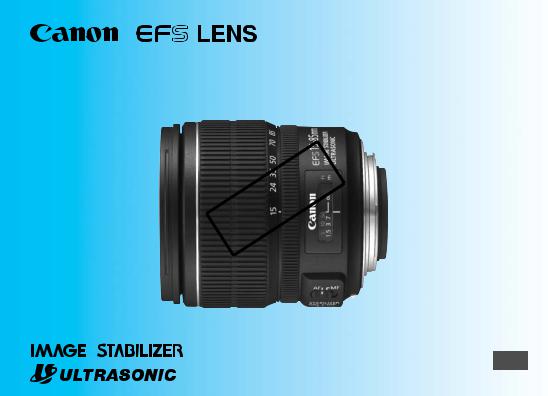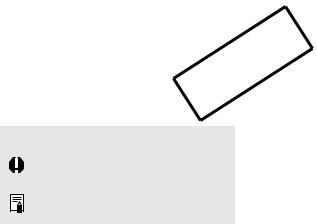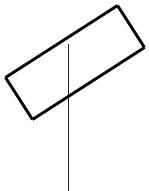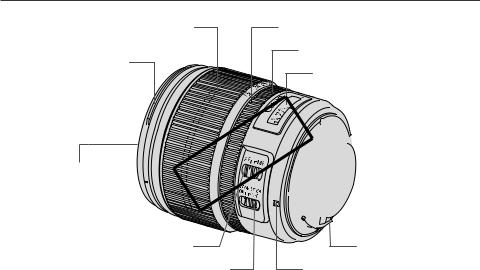Canon EF-S 15-85mm f/3 5-5 6 IS USM Manual

EF-S15-85mm f/3.5-5.6 IS USM
COPY
ENG
Instruction

Thank you for purchasing a Canon product.
The Canon EF-S15-85mm f/3.5-5.6 IS USM |
Features |
||||
lens is a standard zoom lens equipped with |
|
|
|||
1. |
The Image Stabilizer gives the equivalent |
||||
an Image Stabilizer and developed for EOS |
|||||
|
effect of a shutter speed four stops faster*. |
||||
cameras compatible with EF-S lenses.* |
|
||||
|
This function provides optimal image |
||||
|
|
|
|
||
* Only the following cameras are compatible with |
|
|
stabilization depending on shooting conditions |
||
EF-S lenses (as of August 2012): |
|
|
|
(such as shooting still subjects and following |
|
EOS 7D, EOS 60D, EOS 50D, EOS 40D, EOS |
|
|
shots). |
||
30D, EOS 20D, EOS 20Da, EOS REBEL |
|
2. |
Aspherical and UD lens elements result in |
||
T4i/650D, EOS REBEL T3i/600D, EOS REBEL |
|
|
outstanding image delineation. |
||
T2i/550D, EOS REBEL T1i/500D, EOS REBEL |
|
3. |
Ultrasonic motor (USM) for quick and quiet |
||
XSi/450D, EOS REBEL T3/1100D, EOS REBEL |
|
|
autofocusing. |
||
XS/1000D, EOS DIGITAL REBEL XTi/400D |
|
|
|||
|
4. |
Manual focusing is available after the subject |
|||
DIGITAL, EOS DIGITAL REBEL XT/350D |
|
||||
|
|
comes into focus in autofocus mode (ONE |
|||
DIGITAL, EOS DIGITAL REBEL/300D DIGITAL |
|
|
|||
|
|
SHOT AF). |
|||
|
|
|
|
||
¡“IS” stands for Image Stabilizer. |
|
|
|
||
|
|
5. |
A truly round aperture hole results in a nicer |
||
¡“USM” stands for Ultrasonic Motor. |
|
|
|
background blur. |
|
|
COPY |
||||
Conventions used in this instruction
Warning to prevent lens or camera malfunction or damage.
Supplementary notes on using the lens and taking pictures.
*Based on [1/(focal length x 1.6)] second. Generally, it requires a shutter speed [1/focal length] second or faster to prevent camera shake (in 35mm format.
With an EF-S lens, it would be [1/(focal length x 1.6)] second).
ENG-1

a Safety Precautions |
|
|
This device complies with Part 15 of the FCC Rules. Operation is |
|
|
|
subject to the following two conditions: (1) This device may not |
||
• |
Do not look at the sun or a bright light source |
|
cause harmful interference, and (2) this device must accept any |
|
|
through the lens or camera. Doing so could |
|
interference received, including interference that may cause |
|
|
result in loss of vision. Looking at the sun directly |
|
undesired operation. |
|
|
|
Do not make any changes or modifications to the equipment |
||
|
through the lens is especially hazardous. |
|
||
|
|
unless otherwise specified in the instructions. If such changes or |
||
• |
Whether it is attached to the camera or not, do |
|
||
|
modifications should be made, you could be required to stop |
|||
|
not leave the lens under the sun without the |
|
||
|
|
operation of the equipment. |
||
|
lens cap attached. This is to prevent the lens from |
|
This equipment has been tested and found to comply with the |
|
|
concentrating the sun’s rays, which could cause a |
|
limits for a class B digital device, pursuant to part 15 of the FCC |
|
|
fire. |
|
|
Rules. These limits are designed to provide reasonable protection |
|
|
|
|
against harmful interference in a residential installation. This |
|
|
|
|
equipment generates, uses and can radiate radio frequency |
Handling Cautions |
|
|
energy and, if not installed and used in accordance with the |
|
• |
If the lens is taken from a cold environment into |
|
instructions, may cause harmful interference to radio |
|
|
communications. |
|||
|
a warm one, condensation may develop on the |
|
||
|
|
However, there is no guarantee that interference will not occur in |
||
|
lens surface and internal parts. To prevent |
|
||
|
|
a particular installation. If this equipment does cause harmful |
||
|
condensation in this case, first put the lens into an |
|
||
|
|
interference to radio or television reception, which can be |
||
|
airtight plastic bag before taking it from a cold to |
|
determined by turning the equipment off and on, the user is |
|
|
|
COPY |
||
|
warm environment. Then take out the lens after it |
|
encouraged to try to correct the interference by one or more of |
|
|
has warmed gradually. Do the same when taking |
|
the following measures: |
|
|
the lens from a warm environment into a cold one. |
|
• Reorient or relocate the receiving antenna. |
|
|
|
• Increase the separation between the equipment and receiver. |
||
• Do not leave the lens in excessive heat such as in |
|
|||
|
• Consult the dealer or an experienced radio/TV technician for |
|||
|
a car in direct sunlight. High temperatures can |
|
||
|
|
help. |
||
|
cause the lens to malfunction. |
|
|
|
|
|
|
|
|
|
|
|
This Class B digital apparatus complies with Canadian ICES-003. |
|
|
|
|
|
|
|
|
|
|
|
ENG-2

 Nomenclature
Nomenclature
Zoom ring (→ 5)
Hood mount (→ 9)
Zoom position index (→ 5) |
Focusing ring (→ 4) |
Distance scale (→ 5) |
Filter mounting thread (→ 8, 10)
COPY


Focus mode switch (→ 4) |
Contacts (→ 4) |
Image stabilizer switch (→ 6) |
Lens mount index (→ 4) |
For detailed information, reference page numbers are provided in parentheses (→ **).
ENG-3
